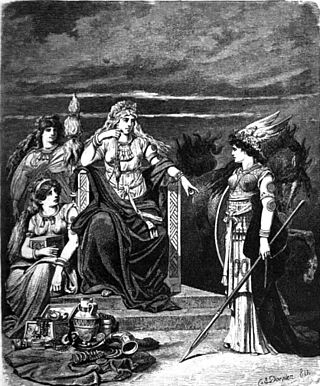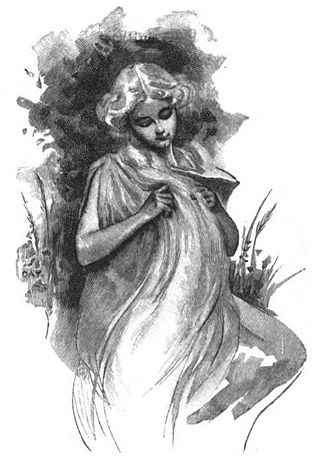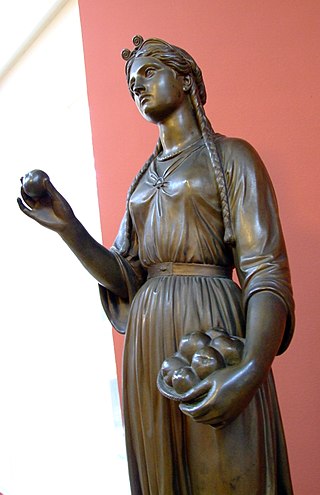Related Research Articles

Hel is a female being in Norse mythology who is said to preside over an underworld realm of the same name, where she receives a portion of the dead. Hel is attested in the Poetic Edda, compiled in the 13th century from earlier traditional sources, and the Prose Edda, written in the 13th century. In addition, she is mentioned in poems recorded in Heimskringla and Egils saga that date from the 9th and 10th centuries, respectively. An episode in the Latin work Gesta Danorum, written in the 12th century by Saxo Grammaticus, is generally considered to refer to Hel, and Hel may appear on various Migration Period bracteates.

In Norse mythology, Gná is a goddess who runs errands in other worlds for the goddess Frigg and rides the flying, sea-treading horse Hófvarpnir. Gná and Hófvarpnir are attested in the Prose Edda, written in the 13th century by Snorri Sturluson. Scholarly theories have been proposed about Gná as a "goddess of fullness" and as potentially cognate to Fama from Roman mythology. Hófvarpnir and the eight-legged steed Sleipnir have been cited examples of transcendent horses in Norse mythology.

In Norse mythology, Sif is a golden-haired goddess associated with earth. Sif is attested in the Poetic Edda, compiled in the 13th century from earlier traditional sources, and the Prose Edda, written in the 13th century by Snorri Sturluson, and in the poetry of skalds. In both the Poetic Edda and the Prose Edda, she is known for her golden hair and is married to the thunder god Thor.

In Norse mythology, Iðunn is a goddess associated with apples and youth. Iðunn is attested in the Poetic Edda, compiled in the 13th century from earlier traditional sources, and the Prose Edda, written in the 13th century by Snorri Sturluson. In both sources, she is described as the wife of the skaldic god Bragi, and in the Prose Edda, also as a keeper of apples and granter of eternal youthfulness.

A kobold is a general or generic name for the household spirit in German folklore. A hausgeist.

Ēostre is a West Germanic spring goddess. The name is reflected in Old English: *Ēastre, Old High German: *Ôstara, and Old Saxon: *Āsteron. By way of the Germanic month bearing her name, she is the namesake of the festival of Easter in some languages. The Old English deity Ēostre is attested solely by Bede in his 8th-century work The Reckoning of Time, where Bede states that during Ēosturmōnaþ, pagan Anglo-Saxons had held feasts in Ēostre's honour, but that this tradition had died out by his time, replaced by the Christian Paschal month, a celebration of the resurrection of Jesus.

According to Tacitus's Germania, Tuisto is the legendary divine ancestor of the Germanic peoples. The figure remains the subject of some scholarly discussion, largely focused upon etymological connections and comparisons to figures in later Germanic mythology.

Germanic paganism or Germanic religion refers to the traditional, culturally significant religion of the Germanic peoples. With a chronological range of at least one thousand years in an area covering Scandinavia, the British Isles, modern Germany, the Netherlands, and at times other parts of Europe, the beliefs and practices of Germanic paganism varied. Scholars typically assume some degree of continuity between Roman-era beliefs and those found in Norse paganism, as well as between Germanic religion and reconstructed Indo-European religion and post-conversion folklore, though the precise degree and details of this continuity are subjects of debate. Germanic religion was influenced by neighboring cultures, including that of the Celts, the Romans, and, later, by the Christian religion. Very few sources exist that were written by pagan adherents themselves; instead, most were written by outsiders and can thus present problems for reconstructing authentic Germanic beliefs and practices.
In Germanic mythology, Seaxnēat or Saxnôt was the national god of the Saxons. He is sometimes identified with either Tīwaz or Fraujaz.
In Anglo-Saxon paganism, Rheda is a goddess connected with the month '"Rhedmonth"'. Rheda is attested solely by Bede in his 8th century work De temporum ratione. While the name of the goddess appears in Bede's Latin manuscript as Rheda, it is reconstructed into Old English as *Hrēþe and is sometimes modernly anglicized as Hretha. Hrēþmōnaþ is one of three events that refer to deities in the Anglo-Saxon calendar—the other two being Ēostermōnaþ and Mōdraniht.

In Norse mythology, Himinbjörg is the home of the god Heimdallr. Himinbjörg is attested in the Poetic Edda, compiled from earlier traditional sources, and the Prose Edda and Heimskringla, both written in the 13th century by Snorri Sturluson. Himinbjörg is associated with Heimdallr in all sources. According to the Poetic Edda, Heimdallr dwells there as watchman for the gods and there drinks fine mead, whereas in the Prose Edda Himinbjörg is detailed as located where the burning rainbow bridge Bifröst meets heaven. Scholars have commented on the differences between the two attestations and linked the name of the mythical location to various place names.

In Norse mythology, Sága is a goddess associated with the location Sökkvabekkr. At Sökkvabekkr, Sága and the god Odin merrily drink as cool waves flow. Both Sága and Sökkvabekkr are attested in the Poetic Edda, compiled in the 13th century from earlier traditional sources, and in the Prose Edda, written in the 13th century by Snorri Sturluson. Scholars have proposed theories about the implications of the goddess and her associated location, including that the location may be connected to the goddess Frigg's fen residence Fensalir and that Sága may be another name for Frigg.
In Germanic paganism, Tamfana is a goddess. The destruction of a temple dedicated to the goddess is recorded by Roman senator Tacitus to have occurred during a massacre of the Germanic Marsi by forces led by Roman general Germanicus. Scholars have analyzed the name of the goddess and have advanced theories regarding her role in Germanic paganism.
Neorxnawang is an Old English noun used to translate the Christian concept of paradise in Anglo-Saxon literature. Scholars propose that the noun originally derives from Germanic mythology, referring to a "heavenly meadow" or place without toil or worries.

In Norse mythology, Sumarr and Vetr ("Winter") are personified seasons. Sumarr and Vetr, personified, are attested in the Poetic Edda, compiled in the 13th century from earlier traditional sources, and the Prose Edda, composed or compiled in the 13th century by Snorri Sturluson. In both, the two are given genealogies, while in the Prose Edda the two figure into a number of kennings used by various skalds.

In Norse mythology, Hjúki and Bil are a brother and sister pair of children who follow the personified Moon, Máni, across the heavens. Both Hjúki and Bil are solely attested in the Prose Edda, written in the 13th century by Snorri Sturluson. Scholarly theories that surround the two concern their nature, their role as potential personifications of the craters on the Moon or its phases, and their relation to later folklore in Germanic Europe. Bil has been identified with the Bilwis, an agriculture-associated figure that is frequently attested in the folklore of German-speaking areas of Europe.

In Germanic mythology, an idis is a divine female being. Idis is cognate to Old High German itis and Old English ides, meaning 'well-respected and dignified woman.' Connections have been assumed or theorized between the idisi and the North Germanic dísir; female beings associated with fate, as well as the amended place name Idistaviso.

In Norse mythology, Dökkálfar and Ljósálfar are two contrasting types of elves; the dark elves dwell within the earth and have a dark complexion, while the light elves live in Álfheimr, and are "fairer than the sun to look at". The Ljósálfar and the Dökkálfar are attested in the Prose Edda, written in the 13th century by Snorri Sturluson, and in the late Old Norse poem Hrafnagaldr Óðins. Scholars have produced theories about the origin and implications of the dualistic concept.
In Norse mythology, the sister-wife of Njörðr is the unnamed twin sister and wife of the god Njörðr, with whom he is described as having had the twin children Freyr and Freyja. This shadowy goddess is attested to in the Poetic Edda poem Lokasenna, recorded in the 13th century by an unknown source, and the Heimskringla book Ynglinga saga, a euhemerized account of the Norse gods composed by Snorri Sturluson also in the 13th century but based on earlier traditional material. The figure receives no further mention in Old Norse texts.
References
- Grimm, Jacob (1882). Teutonic Mythology: Translated from the Fourth Edition with Notes and Appendix by James Stallybrass. Vol. 1. Translated by Stallybrass, James Steven. London: George Bell and Sons.
- Kohl, R. (1936). "Die Augsburger Cisa – eine germanische Göttin?". Archiv für Religionswissenschaft. 33: 21–40.
- Pieper, Christoph (2019). "Germany's Glory, Past and Present: Konrad Peutinger's Sermones convivalesde mirandis Germanie antiquitatibus and Antiquarian Philology". In Enenkel, Karl A.E.; Ottenheym, Konrad A (eds.). The Quest for an Appropriate Past in Literature, Art and Architecture. Brill. pp. 485–510.
- Roper, Lydal (2008). "The Gorgon of Augsburg". In Broomhall, Susan; Tarbin, Stephanie (eds.). Women, Identities and Communities in Early Modern Europe. Ashgate. pp. 113–136.
- Simek, Rudolf (2007). Dictionary of Northern Mythology. Translated by Hall, Angela. Boydell and Brewer. ISBN 978-0-85991-513-7.